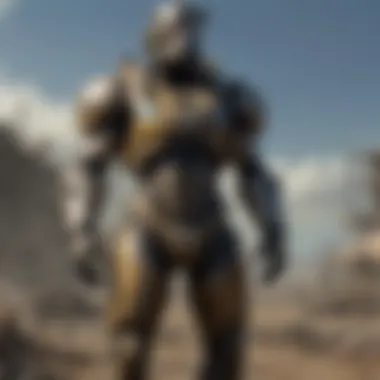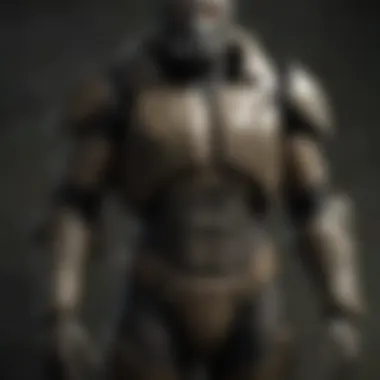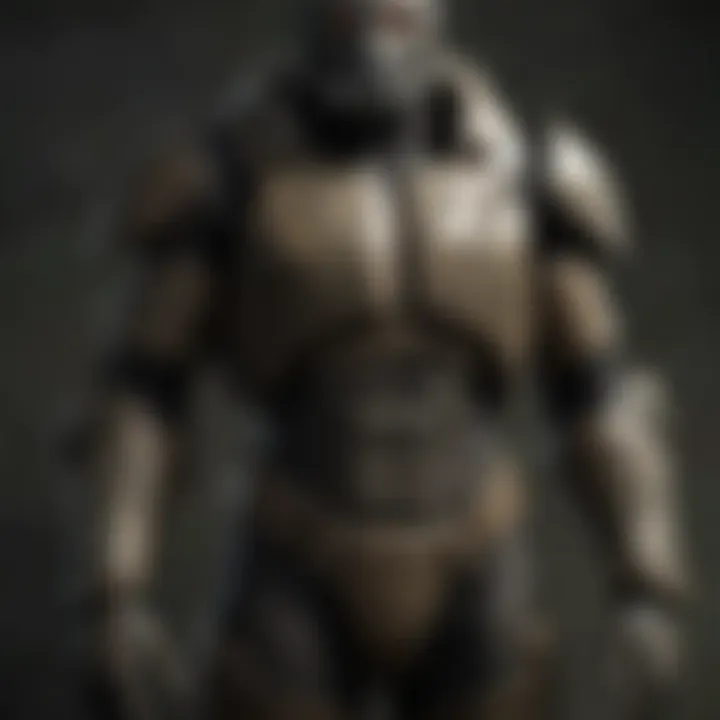The Evolution and Impact of Armour Bodysuits in Gaming


Intro
The post-apocalyptic genre in gaming has carved out its unique niche, with the Fallout series standing tall amongst its peers. The struggle for survival in a world upended by catastrophe not only presents players with challenging gameplay mechanics but also immerses them in rich narratives that go far beyond mere pixelated landscapes. Within this framework, one of the most engaging elements to emerge is the concept of armour bodysuits. These suits, more than just protective gear, symbolize the resilience and adaptability of individuals in a world where safety is a luxury that often comes at a price.
In this article, we delve into the intricacies of armour bodysuits within the Fallout universe, exploring their evolution, design philosophy, and the thematic significance they imbue in post-apocalyptic gaming. Not to mention, we will analyze how these suits enhance player engagement, developing a deeper appreciation for the precarious dance between survival and protection.
Lore Insights
Overview of the Fallout Universe
The Fallout universe is set in a retrofuturistic world that has been ravaged by nuclear warfare. With its alternate history and unique aesthetic, it reflects a 1950s vision of the future that never came to pass. Skyscrapers and vaults built to house humanity during the fallout evoke a sense of lost greatness, while mutated creatures and factions fighting for resources illustrate the harsh realities of life in a nuclear wasteland.
Key Historical Events in the Fallout Timeline
The timeline of Fallout is a convoluted narrative of escalating tensions, technological advancements, and ultimately, a cataclysmic event. Some notable historical milestones include:
- The Resource Wars: Conflicts over dwindling resources set the stage for the eventual nuclear fallout.
- The Great War: Occurred on October 23, 2077, marking the start of the apocalypse with nuclear exchanges between superpowers.
- Establishment of Vaults: The construction of underground vaults intended as shelters for select members of society, leading to various social experiments and outcomes.
Deep Dive into the Backstory of Major Factions and Characters
The factions within Fallout offer a rich tapestry of narratives, each contributing distinct philosophies and playstyles to the overarching plot. Whether it’s the soldierly Brotherhood of Steel, designed to preserve technology, or the ruthless raiders that embody chaos and destruction, each faction serves a purpose in revealing the moral dilemmas faced in a post-apocalyptic landscape. Characters such as the enigmatic Lone Wanderer or the complex protagonist, the Courier, showcase the personal stakes intertwined with larger societal themes.
Prologue
In the realm of gaming, especially within post-apocalyptic narratives, the very fabric of survival is interwoven with characters' utility and protection. The allure of armour bodysuits has captured the imaginations of players, who find themselves navigating hostile landscapes in games like Fallout. With a mixture of necessity and style, these bodysuits reflect a deeper conversation about resilience in dire situations. Understanding how they've progressed over time is essential for grasping the intricate relationship between gameplay mechanics and storytelling.
Context of Post-Apocalyptic Gaming
Post-apocalyptic gaming creates a world where the remnants of civilization clash against the primal instincts of survival. In these settings, players assume roles within devastated environments—fallen cities, barren lands, and shattered societies. The overarching theme typically revolves around survival against the odds, often magnifying humanity's struggle against external threats and internal conflicts. The importance of obtaining protective gear, including armour bodysuits, becomes paramount.
The narrative often explores themes of loss and rebirth, as characters seek to reclaim their humanity amid chaos. Iconic titles, particularly the Fallout series, craft rich universes where the storylines are fueled by the immediate need for protection, thus placing bodysuits at the center of the player experience. What's striking is how these games not only challenge players with survival mechanics but also immerse them in profound existential questions: What does it mean to endure? How do we adapt in the face of destruction? Such questions allude to the significance of bodysuits beyond their physical utility.
Defining Armour Bodysuits
Armour bodysuits serve more than just a protective function in games. They symbolize strength, adaptability, and sometimes the desperation of individuals clinging to survival. Typically made of advanced materials intended to shield players from damage, these suits can vary widely in design—ranging from military-inspired aesthetics to sleek futuristic models.
In the context of Fallout and similar franchises, the definition of armour bodysuits generates layered meanings:
- Physical Protection: The primary and most straightforward attribute, as they often increase a player’s defense against enemies.
- Character Identity: In many titles, how a character dresses speaks volumes. Players craft their identity through the armour choices they make, reflecting personal style amidst the backdrop of devastation.
- Narrative Device: Bodysuits act as vehicles for storytelling, often tied closely to the lore of the game world. Players can engage with the history through different types or styles they encounter, each imbued with its own significance.
Armour bodysuits are thus not merely cosmetic choices but play a vital role in enhancing gameplay while deepening the narrative experience. This blend of utility, identity, and lore surrounding these suits leads to a richer gaming experience, compelling players to think critically about each choice they make in a shattered universe.
Historical Development of Armour Bodysuits
The development of armour bodysuits is a fascinating journey that chronicles not just technological advancements, but changes in societal perception and storytelling in the realm of post-apocalyptic gaming. These suits have come to represent more than mere protection; they embody a blend of survival instinct and creativity in a world left in tatters. Understanding their historical trajectory enables players and enthusiasts to appreciate how gameplay experiences have evolved, along with how narrative and aesthetic choices reflect broader themes of resilience and identity.
Origins in Science Fiction
The seeds of what we now recognize as armour bodysuits were planted in the fertile fields of science fiction literature and film. In the mid-twentieth century, works like "Dune" by Frank Herbert or movies such as "Logan's Run" started to sketch out complex worlds where humanity battled not just for survival, but against existential threats. These narratives introduced iconic images of futuristic protective wear, often characterized by their unique designs and functional capabilities.
In particular, the late 20th century saw the rise of materials like polymers and later advancements in synthetic fibers, which enabled designers to create suits that were both aesthetic and practical. This melding of art and function set the stage for the first in-game appearances of these bodysuits. For example, titles like "Metroid" laid the groundwork for what would become a hallmark of survival games. Much like Samus Aran's iconic Power Suit, early in-game armour designs reflected aspirations of human innovation amidst dire circumstances.
"Science fiction drives imaginative storytelling, creating the framework for future worlds in gaming."
Evolution through Gaming Eras
As gaming evolved, so too did the design and concept of armour bodysuits. The evolution can be divided into several eras that mark key technological and stylistic shifts.
- 8-bit to 16-bit Era: Early games often utilized pixel art to symbolize protection, primarily focusing on symbolic representation of strength rather than detailing. Titles such as "Mega Man" introduced suits that, while rudimentary, hinted at the notion of enhancement through technology.
- 3D Transition: Moving into the late 90s and early 2000s, the graphic revolution brought about a new level of detail. Games like "Fallout 2" illustrated this shift with their intricate character models and expansive customization options. Here, the bodysuit became an essential part of player identity, not just a functional item.
- Modern Gaming: Today, we see a rich tapestry of bodysuit designs influenced by both gameplay mechanics and extensive lore. Titles such as "Fallout 4" and "Metro Exodus" showcase suits that offer immersive experiences, combining utility with striking visuals. Players no longer don just suits; they engage in a full narrative tapestry where the suit itself might carry emotional weight, reflecting hardship and survival.


This evolutionary arc demonstrates that armour bodysuits have not been static constructs; they continually adapt, serving both narrative purposes and gameplay mechanics. Through understanding their historical context, players can better appreciate the meticulous craftsmanship that contributes to the storytelling in post-apocalyptic settings.
Design and Aesthetics
The design and aesthetics of armour bodysuits in post-apocalyptic gaming serve as more than just surface decoration; they extend into the very essence of gameplay and narrative. These suits represent not merely a protective gear but a statement about survival, identity, and the environment they inhabit. The intricate details and choices made in their design can deeply affect how players perceive their character’s journey through a desolate world.
Materials and Technology
In the realm of post-apocalyptic gaming, the materials used in the design of bodysuits often reflect both technological advancements and the decaying remnants of a once thriving society. For instance, high-density polyethylene and ceramic composites may be utilized, providing armor that is both lightweight and resistant to damage. These materials suggest a blend of old and new, showcasing innovation within a context of scarcity.
Additionally, advancements in technology allow for integrated systems. Some bodysuits come equipped with biomechanical enhancements like exoskeleton features that enable players to perform tasks that would typically be impossible—like lifting heavy items—and offer a tremendous edge during combat. In Fallout, players can find suits infused with retro-futuristic technology, combining classic science fiction motifs with practical gameplay mechanics. This fusion of aesthetics and function serves to enhance not only player engagement but also immersion in the game world.
Visual Styles Across Game Titles
The visual representation of armour bodysuits varies dramatically across different game titles, each contributing uniquely to the overall atmosphere and player experience. In the Fallout series, players encounter a myriad of styles—from the utilitarian, patched-together designs of the Wasteland wanderers to the sleek, retro-futuristic lines of the Advanced Power Armor. Each suit often symbolizes the factions from which they originate—merging cultural elements seamlessly into their visual design.
Other games, like Metro Exodus, take a more gritty, realistic approach. Their bodysuits appear worn, frayed, and patched up, reflecting the harsh conditions and the struggle to survive in an unforgiving environment. This stylistic choice not only creates a visual connection to the narrative but also reinforces the themes of resilience and adaptation in the face of despair.
"In the end, the aesthetic choices in armour bodysuits are often a mirror reflecting the player's choices and the world around them."
Players may find themselves drawn into these visual styles, as they resonate on both emotional and intellectual levels, allowing for deeper connections to characters' identities.
By using materials that correlate with their surroundings and presenting visually distinct styles, these bodysuits become symbols of survival, growth and, ultimately, the choices that shape a player's journey. Overall, the design and aesthetics intertwine with gameplay mechanics and narrative depth, leading to an enriching player experience.
Functional Aspects of Armour Bodysuits
The integration of armour bodysuits in post-apocalyptic gaming is more than just a aesthetic choice; it's a fundamental component that drives gameplay mechanics and enhances player experience. These suits are not merely protective garments but serve as vital tools for navigating the harsh realities of virtual worlds, specifically in settings like the Fallout series. Understanding their functional aspects offers insight into how they elevate the immersive quality of these games.
Gameplay Integration
In many post-apocalyptic games, players encounter a deluge of threats, from mutated creatures to hostile human factions. This is where the gameplay integration of armour bodysuits shines. They are designed to serve a multiplicity of functions, often dictated by the environment and the enemies that roam within it.
- Protection Mechanism: The most obvious function is providing physical protection. For example, in Fallout 4, the Power Armor acts not only as a shield but also as a means of survival amidst a nuclear wasteland. It offers high damage resistance, allowing players to engage enemies without succumbing to injury.
- Resource Management: These suits often require power sources or fuel, which adds a layer of strategy. Players must balance the use of their resources with the advantages provided by their suits, leading to compelling decision-making moments.
- Skill Enhancement: Some suits enhance specific skills or abilities. In the Fallout universe, wearing certain types of body armor can augment players' agility or strength, impacting overall gameplay. This interplay between the equipment and player tactics becomes crucial as it shapes combat styles and exploration strategies.
- Customization and Upgrades: Many games include systems to modify and upgrade these suits, which further deepens engagement. Players can personalize their gear according to their play styles, leading to a unique gameplay experience. Whether crafting new modules for stealth or enhancing defensive capabilities, this adaptability enriches player agency.
Balance between Offense and Defense
The design of armour bodysuits navigates the delicate tightrope between offense and defense, becoming essential in a gameplay environment fraught with danger. This balance is pivotal, as it influences players' strategic choices and encounter tactics.
- Defensive Stats: In manyInstances, players have to choose between heavier armor that offers better defense but limits movement and lighter armor that provides agility but less protection. For instance, Equipping the T-60 Power Armor in Fallout 4 grants superior resistance, yet you might sacrifice speed.
- Offensive Capabilities: Conversely, some bodysuits may provide melee enhancements or bonuses to ranged damage, offering offensive advantages while potentially reducing protective attributes. This variance means players must analyze each situation, weighing the risks against the potential rewards.
- Situational Awareness: The decision-making aspect emphasizes situational awareness. Players might find themselves in a sluggish defense posture vs. an aggressive offense based on the bodysuit they decide to equip. Thus, the gameplay becomes a high-stakes chess match where every move counts.
- Team Dynamics: In multiplayer modes, the armor’s functions can also come into play. A player might take on a tank role, equipped with heavily fortified armor, while teammates provide ranged support or heavy hitting from a distance. The synergistic use of different bodysuits can sway the outcome of engagements, reflecting the essence of teamwork in a post-apocalyptic landscape.
"In post-apocalyptic environments, making the right choice of armour can mean the difference between life and death."
The functional aspects of armour bodysuits are intricately woven into the fabric of gameplay, impacting not just individual player experience but also the broader narrative within post-apocalyptic gaming. Through thoughtful integration of gameplay mechanics and the balance of offense and defense, these suits embody resilience and adaptability in a world gone awry.
Thematic Significance
The thematic significance of armour bodysuits in post-apocalyptic gaming transcends mere aesthetics or gameplay mechanics; they are pivotal to understanding narrative and character dynamics within this genre. These suits embody resilience, survival, and identity, acting as symbols reflecting the inner struggles of characters navigating a ravaged world. In many ways, they are the second skin of heroes—or antiheroes—profoundly influencing players' emotional connections to their avatars and the environments they inhabit.
Survival in Hostile Environments
In post-apocalyptic settings, the very essence of survival is a recurring theme, and armour bodysuits play a crucial role in reinforcing this notion. These suits are often depicted as essential gear for characters facing perilous circumstances, such as radiation, extreme weather, and hostile creatures. The materials and technologies employed in these designs can range from sleek, lightweight fabrics to heavy, reinforced plating, a deliberate choice reflecting the intense challenges present in these game worlds.
For instance, in the Fallout series, the iconic Power Armor represents a significant leap in survival technology. It not only provides physical protection but also enhances the user's strength and resilience in an otherwise unforgiving landscape. Players often find themselves grappling with choices about when to don this heavy protection, illustrating a vital gameplay dilemma—staying agile versus being armored.
"The survival instincts of characters are amplified through the need for strategic armor selection, making players constantly weigh their options."
Thus, the way these bodysuits embody survival also speaks to larger themes of humanity's adaptability. They symbolize the ongoing struggle to find security amidst chaos, a reflection of real-world challenges faced in times of strife. Moreover, as players navigate these hostile environments, the presence of bodysuits underscores the importance of preparation, resilience, and innovation.
Identity and Self-Expression of Characters


Armour bodysuits are not solely functional; they are intricately tied to character identity and self-expression. In a world stripped of societal norms, these suits allow characters to communicate crucial aspects of their personality, allegiances, and even previous life experiences. Through customization options, players can pick and choose how to represent their avatars, leading to a diverse tapestry of character presentation that resonates on an emotional level.
Take, for example, the various factions within Fallout, each with its distinct style of armour that tells a story. Whether it’s the rusted toughness of raider armor or the pristine, high-tech appearance of the Brotherhood of Steel, the designs convey cultural background and values. A player’s choice of bodysuit can therefore signify their personal ethos or philosophy about survival, trust, and morality.
In this way, the choices associated with bodysuits enable deeper engagement with the narrative. Players are not just donning practical gear; they are weaving themselves into the storytelling fabric, highlighting their role in a broader struggle. These decisions often lead to emergent storytelling, where a player’s journey becomes uniquely personal, intertwined with character growth and identity.
Ultimately, the thematic significance of armour bodysuits lies in their multifaceted nature—they foster survival, enhance gameplay, and facilitate identity exploration, weaving together the intricate relationship between characters and the harsh worlds they inhabit.
Notable Examples in Gaming
When discussing armour bodysuits in the realm of post-apocalyptic gaming, it's imperative to spotlight their notable examples. These suits not only embody the survival instincts of their wearers but also serve as crucial elements in gameplay and narrative development. The intricacies of design and function are brought to life through the experiences of players, crafting a memorable journey.
Fallout Series Innovations
Within the Fallout series, the evolution of armour bodysuits stands out significantly. From the Vault Suit to the advanced power armor, each design modification reflects the game's trajectory through an increasingly hostile landscape.
- Vault Suit: The iconic blue and yellow jumpsuit represents hope and security in the original games. It allows players a glimpse into the lives of pre-war citizens and their attempts to adapt to new realities. Its practical design encourages exploration while offering limited protection.
- Power Armor: The starring element of Fallout’s innovative approach is undoubtedly the Power Armor. This heavy-duty suit not only boosts strength but also represents a stark contrast to the wasteland's decay. Developed from a military background, its complex mechanics serve as both an offensive and defensive powerhouse. Players gain a sense of immense power, underscoring the harsh contrast between the worn landscape and the protective shell. The progression from acquiring basic models to more robust versions parallels the narrative arc of growth and triumph against adversity.
The Fallout series ensures that each instance of bodily armor isn’t just about stats. It's about weaving together narrative, gameplay, and emotional engagement. The Power Armor, with its glaring lights and steely exterior, evokes a sense of nostalgia while signifying persistence and human ingenuity in face of a broken world.
Comparison with Other Franchises
Exploring the concept of armour bodysuits in other gaming franchises reveals distinct approaches and thematic placements. Each title has used bodysuits to draw players into unique interpretations of survival and adaptation.
- Mad Max: The Mad Max series leans heavily into the gritty reality of resource scarcity. The protagonist's gear is often improvised, showcasing the harshness that defines the wasteland. Unlike Fallout, where high-tech solutions exist, Mad Max utilizes salvaged parts to create bodysuits that emphasize vulnerability amid mayhem. This perspective on armour highlights the notion that protection can often come from ingenuity rather than technology.
- Metro Series: In contrast, the Metro series integrates bodysuits as essential tools for survival against environmental hazards. The gas mask and armored clothing symbolize the perilous journey through nuclear remnants. It effectively builds tension, as each encounter can lead to the loss of precious oxygen or safety. Here, armour serves not only as protection but as a constant reminder of the dangers that lurk beneath the surface.
- Horizon Zero Dawn: On a different note, Horizon Zero Dawn introduces a blend of ancient aesthetics with futuristic technology. The protagonist, Aloy, dons technologically advanced suits that connect her with her surroundings. Rather than merely a defense mechanism, these suits signify identity and a connection to her heritage, demonstrating a fascinating contrast in the role of bodysuits within the post-apocalyptic narrative.
Each of these examples illustrates how other franchises leverage the concept of armour bodysuits to craft immersive worlds. They vary greatly in form and functionality, reflecting not just the aesthetic choices of designers but the philosophical quandaries surrounding survival, morality, and identity.
"Armour bodysuits are the silent narrators of their worlds, conveying stories of resilience that echo through the wasteland beyond the screen."
Bringing together these disparate examples paints a fuller picture of how deeply embedded armour bodysuits are within the mechanics of gameplay and narrative, no matter the franchise.
Player Interaction and Immersion
In post-apocalyptic gaming, player interaction and immersion stand as critical components in crafting a meaningful experience. These aspects not only enhance the emotional grip of the narratives but also shape how players relate to the world around them. The interplay between the player and their avatar is intensified through the integration of armour bodysuits, which act as a bridge between the character's journey and the player's own engagement within that journey.
Armour bodysuits in games like Fallout serve not merely as protection but as a form of self-expression for players. This customization allows for a personal touch, letting players decide the look and feel of their character's gear. It’s all about making choices that resonate on a deeper level. The visible differences in these selections become markers of identity, and they reflect the player's approach to gameplay strategies. A player who opts for aesthetic options may role-play their character differently than someone who wears heavy-duty, utilitarian suits designed for maximum defense.
"In post-apocalyptic environments, the colour and style of an armour bodysuit can speak volumes about its wearer, telling stories of survival, lifestyle, and values."
Customisation options appeal not just to aesthetic sensibilities but also to practical gameplay mechanics. Players can tailor their bodysuits to fit specific challenges, enabling strategies that reflect their play style. In the wasteland, this personalization can mean the difference between life and death.
Customisation Options
Customization has become an integral feature of many games, and Fallout excels in allowing players to refine their armour bodysuits. Choosing different materials or enhancements, like energy resistance or stealth capabilities, reflects a strategic choice that aligns with a player's gaming approach. Here are several key elements of customization available in games:
- Aesthetic Choices: Players can select colours, motifs, and symbols that resonate with their preferences or even represent various factions.
- Functional Upgrades: Adding enhancements like better insulation, weight reductions, or damage absorption contributes to a character’s survival chances and aligns with individual gameplay styles.
- Visual Modifications: From battle-worn scars to fresh paint jobs, visual modifications allow players to narrate their journey visually.
Through these choices, players feel a stronger connection to their characters and the game’s universe, often revealing personal pride in their unique creations. The consequences of their choices become apparent through interaction with other players and NPCs, heightening the immersion factor.
Effects on Gameplay Experience
The impact of armor bodysuits on gameplay experience cannot be overstated. When players don a suit, they step into a role that is layered with complexity. They’re not just controlling characters; they’re embodying them. This transition from detached observer to engaged participant fosters a deeper emotional investment in the game.
- Enhanced Engagement: Customizing a character increases the likelihood of emotional investment in that character’s fate. Players care more about the outcomes and decisions presented in the storyline, leading to more thoughtful interactions.
- Dynamic Gameplay: Choosing different bodysuits can alter interactions within the game, affecting how NPCs respond or how certain missions unfold. For example, approaching a quest with heavy armor might invoke fear or respect, while a stealth suit opens up other dialogue options and strategies.
- Immersive Storytelling: The personal narrative players create through their choices enriches the story, making it feel like a unique experience. It allows for storytelling that evolves through player actions rather than a rigid, scripted narrative.
In essence, armour bodysuits effectively serve as a powerful avenue for player interaction and immersion. By allowing players to shape their experience through customizable options and impacting gameplay mechanics, these suits create not just survival stories but also profound connections to the game's overarching themes.
Cultural Impact


The cultural impact of armour bodysuits in post-apocalyptic gaming extends far beyond mere aesthetics or gameplay mechanics. These suits serve as symbols, representing not only the resilience of characters but also the human spirit itself amidst desolation. In a world where everything seems to be falling apart, the notion that one can don a suit that offers protection, agility, and adaptability resonates deeply with players. The incorporation of these bodysuits into storytelling within games like Fallout speaks volumes about the themes of survival and identity, adding layers of meaning that connect players emotionally to the narrative.
One can't help but notice how these bodysuits have influenced various facets of culture, from fashion trends to media portrayals. They encapsulate the gritty charm of survival in hostile environments, inviting admiration and inspiring creativity. Let's delve deeper into some specific elements surrounding this cultural influence:
Influence on Fashion and Media
Armour bodysuits have transcended gaming and seeped into real-life fashion and media portrayals. Designers and enthusiasts have embraced the rugged yet futuristic look offered by these suits, often incorporating elements of them into streetwear and high fashion. The aesthetic appeal of the weathered materials, intricate stitching, and sometimes metallic finishes can be seen in fashion lines that celebrate a dystopian ethos.
In various fashion weeks, just as an example, collections have featured ensembles that echo the gritty yet glamorous style of characters from the Fallout franchise. This cross-pollination signifies how gaming culture has infiltrated the fashion industry, demonstrating that what once was digital can be worn in the streets. Moreover, documentaries and articles explore this evolution, often giving nods to video games that inspire trends.
As for media, the influence is visible in movies and TV shows that feature post-apocalyptic settings. Visual narratives often depict characters in bodysuits reminiscent of what gamers wear. The suit is no longer just a piece of virtual attire; it has become a cultural artifact that signifies readiness to confront adversity, embodying both style and substance. The influence of Fallout on major production designs showcases how intertwined the gaming and entertainment industries have become, paving the path for future projects to draw upon this well-crafted influence.
Representation in Other Forms of Art
Beyond fashion and media, the artistic representation of armour bodysuits finds its home in a multitude of other artistic forms. Artists, painters, and sculptors often draw inspiration from the unique designs of these suits, translating their ruggedness into visual art. This happens through various mediums—be it in illustrations for graphic novels, concept art for new video games, or even installations in galleries.
For instance, many fan art communities on platforms like Reddit and DeviantArt regularly showcase artworks that celebrate the intricate designs of bodysuits from franchises such as Fallout. These creations serve to honor the spirit of the game while showcasing personal artistic interpretation, solidifying how these suits inspire talent beyond gaming.
Additionally, performances and interactive art pieces take the concept of bodysuits into a different realm, often exploring themes of human adaptability and survival in a more visceral manner.
"These bodysuits become living canvases, embodying the struggle of existence in a world scattered with remnants of the past."
Hence, as we explore the cultural implications of armour bodysuits, it becomes clear they play a significant role in shaping artistic expression, fueling creativity, and contributing to broader conversations about identity, conflict, and resilience. Through their evolution and representation, these suits have firmly entrenched themselves into the fabric of contemporary culture, inviting discussions that echo the struggles found within the confines of a digital apocalypse.
Future Trends in Armour Bodysuits
The armour bodysuit has come a long way since its inception in the gaming world, but it looks poised to evolve even further. As technology advances and player expectations shift, the design and functionality of bodysuits in post-apocalyptic gaming are set to lead a new wave of innovations. Understanding these future trends is crucial for both developers and players alike, as they dive deeper into creating more immersive experiences.
Technological Advances
As gaming technology races forward, the potential for armour bodysuits to integrate cutting-edge tech is immense. We can expect the following improvements:
- Enhanced Materials: New, lightweight composite materials could replace traditional fabrics, offering better durability and comfort while maintaining a sleek aesthetic.
- Smart Technology Integration: Imagine a bodysuit that monitors health metrics and adjusts its functions based on player performance. Features like temperature control and energy absorption could bring a new dimension to gameplay experience.
- Augmented Reality Features: With AR steadily growing in relevance, future bodysuits might have augmented abilities. Players could see real-time stats or map overlays directly through their armour, making strategic decisions more instinctual.
These advancements not only elevate the design of the bodysuits but also significantly impact player immersion and experience.
Anticipated Gameplay Innovations
Looking ahead, gameplay mechanics could see a shake-up influenced by the evolution of the bodysuits. Here’s what players might expect:
- Dynamic Suit Transformations: Players could customize their bodysuit on-the-fly, adjusting its capabilities based on the immediate environment or threats. For instance, a suit could enhance stealth features in urban surroundings while beefing up armor in open areas.
- Synergy with Environment: Future games might allow players to utilize their bodysuits for more than mere protection. Picture a bodysuit that can harness energy from the environment, enhancing abilities or bestowing temporary buffs.
- Real-Time Adaptation Mechanism: Bodysuits could react to in-game events, modifying their appearance or abilities based on the player's choices or environmental cues, thus creating a tailor-made experience.
“The future of armour bodysuits isn’t just about protection, it’s about creating a narrative of survival that goes beyond the screen.”
These innovations will enrich storytelling in games, making the experience more connected and complex. The evolution of bodysuits represents more than functionality; it’s about enhancing the journey of survival in desolate landscapes.
In summary, as technology progresses, so will the potential of armour bodysuits in gaming. This will ultimately reshuffle how players interact with their environments, driving engagement and immersion in post-apocalyptic narratives.
The End
As we draw the curtains on the discussion surrounding armour bodysuits in post-apocalyptic gaming, it becomes quite evident that these garments are more than just a protective layer. They are significant symbols encapsulating the challenges and philosophies inherent in a ravaged world. The intersection of technology, aesthetics, and narrative within games like Fallout illustrates how crucial armour bodysuits are to the overarching themes of survival and resilience.
Summary of Key Insights
In reviewing the evolution and impact of these intricate designs, several key insights emerge:
- Heritage and Influence: The origins of bodysuits trace back through decades of science fiction and design evolution, making them an essential part of gaming history.
- Design Complexity: The range of materials and technology implemented informs players' choices and strategies, bringing a layer of depth to gameplay that enhances immersion.
- Player Experience: Customization options not only allow for personal expression but also reflect individual gameplay styles, making the interaction richer.
- Cultural Footprints: The influence of armour bodysuits stretches beyond gaming, permeating fashion and other media, illustrating their cultural significance.
"In a world where every decision can be a matter of survival, the bodysuit becomes not just armor, but an extension of the self in the face of adversity."
Final Thoughts on Armour Bodysuits in Gaming
Reflecting on the significance of armour bodysuits in post-apocalyptic games, one can't help but consider their dual nature—they are protective yet expressive, functional yet symbolic. As players navigate through hazardous terrains and confront daunting challenges, these suits serve as critical tools, enabling the survival instinct while fostering a deeper connection between the player and their character. Their evolution is set to continue alongside innovations in technology and design, ensuring that their relevance in gaming remains steadfast.
The future may hold even more intricate designs that echo not only the moods of the game but also the psychological states of the characters adorned in them. This evolving relationship between players and their virtual armors paves the way for an ever-deepening narrative experience, making it a captivating area of exploration in game design. For fans of the Fallout series and beyond, it's clear that armour bodysuits will remain at the forefront of post-apocalyptic gaming, reflecting the ongoing dance between vulnerability and power.







